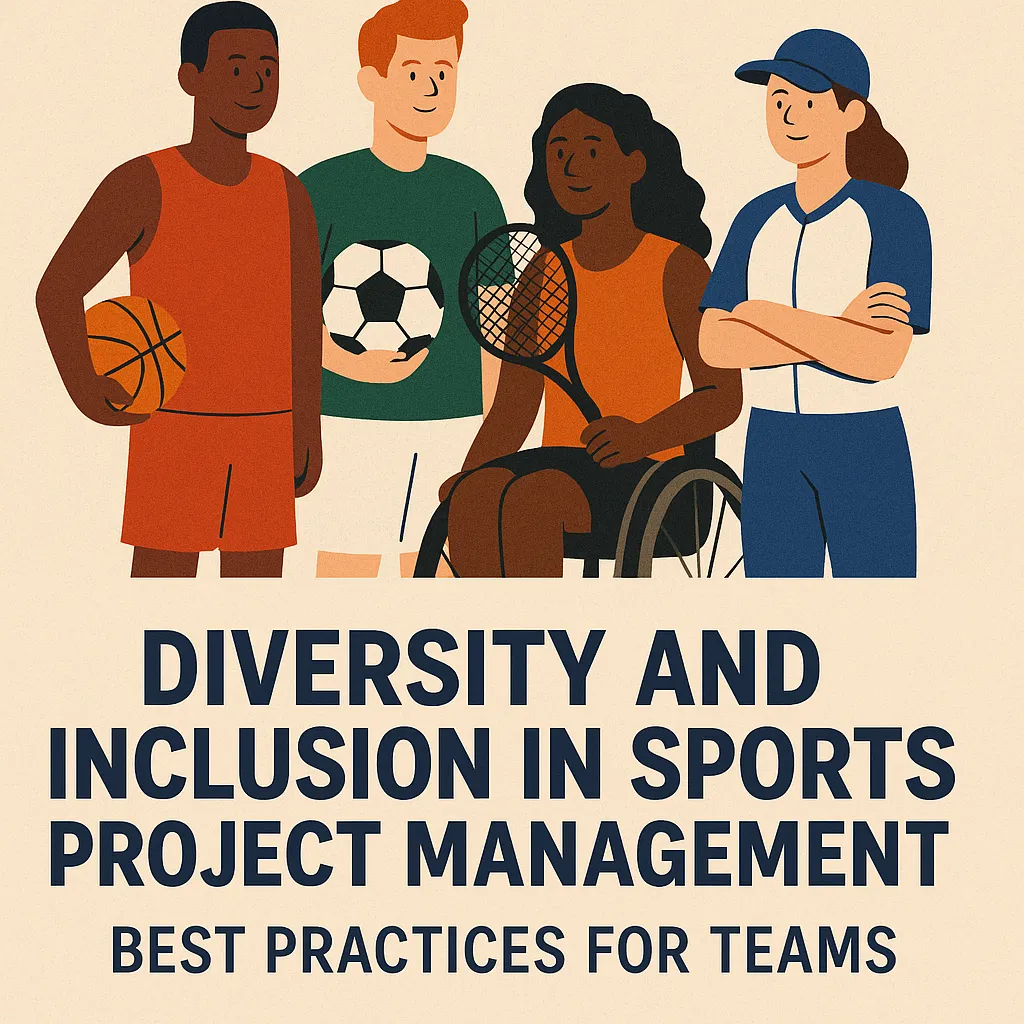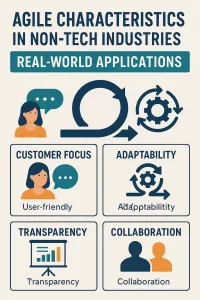Introduction
Project management in the context of sports involves the planning, execution, and oversight of various initiatives aimed at achieving specific goals within sports organizations. This can include everything from organizing events, managing teams, and developing marketing strategies to enhancing fan engagement and improving athlete performance. Effective project management in sports requires a unique blend of skills, including leadership, communication, and strategic thinking, all tailored to the dynamic and often unpredictable nature of the sports industry.
Diversity and inclusion are critical concepts that have gained significant attention in recent years, particularly in organizational settings. Diversity refers to the presence of differences within a given setting, encompassing various dimensions such as gender, race, age, cultural background, and more. Inclusion, on the other hand, is about creating an environment where all individuals feel valued, respected, and empowered to contribute their unique perspectives. In sports project management, these concepts are not just buzzwords; they are essential components that can drive innovation, creativity, and overall project success.
The relevance of diversity and inclusion in sports project management cannot be overstated. A diverse team brings together a wide range of experiences and viewpoints, which can lead to more comprehensive problem-solving and decision-making processes. Research indicates that teams with diverse members are more likely to outperform their homogeneous counterparts, as they can approach challenges from multiple angles and generate more innovative solutions. Furthermore, fostering an inclusive environment enhances team cohesion and morale, which are vital for the successful execution of projects in the fast-paced sports industry. By prioritizing diversity and inclusion, sports organizations can not only improve their project outcomes but also create a more equitable and engaging atmosphere for all stakeholders involved.
The Importance of Diversity in Sports Project Management
The composition of the team plays a pivotal role in determining the success of any initiative. Emphasizing diversity within teams is not merely a matter of social responsibility; it is a strategic advantage that can lead to enhanced performance and innovation. Here are several key points that illustrate why diversity is crucial for effective project management in sports.
- Diverse Perspectives and Ideas: Teams that are diverse in terms of gender, ethnicity, and background bring a wealth of different perspectives and ideas to the table. This variety fosters creativity and encourages out-of-the-box thinking, which is essential in the fast-paced and ever-evolving sports industry. When team members come from different cultural backgrounds, they can contribute unique insights that may not be apparent to a more homogenous group, leading to more comprehensive and innovative solutions to challenges faced in sports projects [1].
- Improved Performance and Innovation: Numerous studies have shown that diverse teams tend to outperform their less diverse counterparts. For instance, research indicates that organizations with higher diversity levels are more likely to experience increased innovation and better financial performance. In the context of sports, this translates to more effective marketing strategies, enhanced fan engagement, and improved overall project outcomes. The NCAA, for example, conducts diversity education workshops that highlight the benefits of diverse teams in fostering a more inclusive environment, which can lead to better project results [4][5].
- Enhanced Problem-Solving and Decision-Making: Diversity significantly impacts problem-solving and decision-making processes. Teams that include members with varied experiences and viewpoints are better equipped to analyze situations from multiple angles, leading to more thorough evaluations of potential solutions. This is particularly important in sports project management, where decisions can have far-reaching implications for team dynamics, fan engagement, and overall project success. By leveraging the strengths of a diverse team, project managers can ensure that decisions are well-informed and reflective of a broader range of stakeholder interests [6][9].
Understanding Inclusion in Team Dynamics
The concepts of diversity and inclusion are pivotal for fostering a healthy and productive team environment. Understanding how these elements interact can significantly enhance project outcomes and team dynamics.
Defining Inclusion and Its Relationship with Diversity
Inclusion refers to the practice of creating an environment where all individuals feel valued, respected, and empowered to contribute, regardless of their background. It goes beyond mere representation; inclusion ensures that diverse voices are heard and considered in decision-making processes. Diversity, on the other hand, encompasses the variety of differences among people, including race, gender, age, cultural background, and more. Together, diversity and inclusion create a framework that promotes respect, equality, access, and opportunity for all team members, which is essential for effective project management in sports [6].
Enhancing Team Cohesion Through Inclusive Practices
Inclusive practices are crucial for enhancing team cohesion. When team members feel included, they are more likely to engage actively, share ideas, and collaborate effectively. This sense of belonging can lead to increased motivation and commitment to project goals. For instance, sports organizations that actively recruit athletes from diverse backgrounds and create an environment that celebrates this diversity can foster a more cohesive team dynamic [2]. Furthermore, regular team-building activities that cater to diverse interests can encourage participation from all employees, thereby strengthening team bonds [9].
Examples of Inclusive Behaviors Benefiting Project Management
Implementing inclusive behaviors can significantly benefit project management in sports. Here are some examples:
- Encouraging Diverse Perspectives: Actively inviting team members from different genders, cultural backgrounds, or age groups to contribute to discussions can lead to innovative solutions and a broader understanding of challenges [8].
- Creating Safe Spaces for Dialogue: Establishing an environment where team members feel safe to express their thoughts and concerns fosters open communication and trust, which are essential for effective collaboration.
- Recognizing and Valuing Contributions: Acknowledging the unique contributions of each team member, regardless of their background, reinforces their value within the team and encourages ongoing participation.
- Providing Equal Opportunities for Leadership: Ensuring that leadership roles are accessible to individuals from diverse backgrounds can enhance representation and inspire others within the team to strive for similar positions [3].
Best Practices for Building Diverse Teams in Sports Projects
Diversity and inclusion are not just buzzwords; they are essential components that can significantly enhance team performance and project outcomes. Here are some actionable strategies for HR professionals and team leaders to foster diversity within their project teams:
Strategies for Recruiting Diverse Talent in Sports Organizations
- Active Recruitment Efforts: Sports organizations should actively seek to recruit athletes and professionals from diverse backgrounds. This can be achieved by partnering with community organizations, attending job fairs that focus on underrepresented groups, and utilizing platforms that cater to diverse talent pools [1].
- Inclusive Job Descriptions: Craft job descriptions that emphasize the organization’s commitment to diversity and inclusion. Use language that is welcoming and encourages applicants from various backgrounds to apply [1].
- Diverse Hiring Panels: Implement diverse hiring panels to minimize bias in the recruitment process. This not only helps in selecting candidates from varied backgrounds but also signals to potential hires that the organization values diversity [1].
Techniques for Ensuring Equitable Opportunities within Project Teams
- Clear Goals and Objectives: Clearly define team goals and objectives to ensure that all team members understand their roles and contributions. This clarity helps in creating an equitable environment where everyone feels valued and accountable [5].
- Employee Mobility and Cross-Training: Promote employee mobility and cross-functional collaboration. This allows team members to gain diverse experiences and perspectives, which can enhance creativity and problem-solving within the project [8].
- Regular Feedback Mechanisms: Establish regular feedback mechanisms to assess team dynamics and ensure that all voices are heard. This can include surveys, one-on-one check-ins, and team meetings focused on inclusivity [3].
Methods for Promoting a Culture of Inclusion and Respect
- Effective Communication: Foster an environment of clear, open, and inclusive communication. Encourage team members to share their ideas and perspectives, and ensure that discussions are respectful and constructive [7].
- Training and Development: Provide training on diversity and inclusion for all team members. This can help raise awareness about unconscious biases and equip team members with the skills to engage respectfully with one another [1].
- Celebrating Diversity: Create opportunities to celebrate the diverse backgrounds of team members. This could include cultural awareness events, team-building activities that highlight different cultures, and recognition of diverse contributions to the project [1].
By implementing these best practices, HR professionals and team leaders can build diverse teams that not only reflect the rich tapestry of the sports community but also drive project success through varied perspectives and innovative solutions. Embracing diversity in sports project management is not just beneficial; it is essential for fostering a culture of inclusion and respect that leads to high-performing teams.
The Role of Leadership in Promoting Diversity and Inclusion
The role of leadership is pivotal in fostering a diverse and inclusive environment. Leaders who prioritize diversity not only enhance team dynamics but also drive project success. Here are some key points to consider regarding the qualities of effective leaders, their modeling of inclusive behaviors, and successful initiatives in the sports sector.
Qualities of Leaders Who Champion Diversity and Inclusion
- Visionary Thinking: Effective leaders possess a clear vision that includes diversity as a core value. They understand that a diverse team brings varied perspectives, which can lead to innovative solutions and improved decision-making processes. This visionary approach is essential for creating an inclusive culture within sports organizations [1].
- Empathy and Emotional Intelligence: Leaders who demonstrate empathy and emotional intelligence are better equipped to understand the unique challenges faced by team members from diverse backgrounds. This quality allows them to create a supportive environment where everyone feels valued and heard [2].
- Commitment to Continuous Learning: Leaders must be open to learning about different cultures, experiences, and perspectives. This commitment not only enhances their understanding of diversity but also sets a precedent for team members to engage in similar learning opportunities [3].
Modeling Inclusive Behaviors
- Open Communication: Leaders can foster an inclusive environment by promoting open communication. This involves actively listening to team members, encouraging feedback, and ensuring that all voices are heard during discussions. By doing so, leaders demonstrate that every team member’s input is valuable [4].
- Diverse Hiring Practices: Leaders should advocate for and implement diverse hiring practices. This includes creating job descriptions that appeal to a wide range of candidates and ensuring that recruitment processes are free from bias. By prioritizing diversity in hiring, leaders can build teams that reflect a variety of backgrounds and experiences [5].
- Recognition and Celebration of Diversity: Leaders can model inclusive behaviors by recognizing and celebrating the diverse backgrounds of their team members. This can be achieved through initiatives such as cultural awareness events, diversity training sessions, and recognition programs that highlight the contributions of individuals from various backgrounds [6].
Examples of Successful Leadership Initiatives in Sports Project Management
- Diversity Training Programs: Many sports organizations have implemented diversity training programs aimed at educating leaders and team members about the importance of inclusion. These programs often focus on unconscious bias, cultural competency, and effective communication strategies, equipping leaders with the tools they need to foster an inclusive environment [7].
- Mentorship Programs: Successful sports organizations have established mentorship programs that pair diverse team members with experienced leaders. These initiatives not only support the professional development of underrepresented individuals but also help to create a culture of inclusion and support within the organization [8].
- Inclusive Policy Development: Leaders in sports project management have taken the initiative to develop and implement inclusive policies that promote equity and anti-discrimination. These policies serve as a framework for ensuring that all team members have equal opportunities to succeed and thrive within the organization [9].
Measuring Success: Metrics for Diversity and Inclusion in Sports Projects
Fostering diversity and inclusion is not just a moral imperative but a strategic advantage. For HR professionals and team leaders, understanding how to measure the success of diversity and inclusion initiatives is crucial for driving project success. Here are some key points to consider:
Key Performance Indicators (KPIs) for Diversity and Inclusion
- Representation Metrics: Track the demographic composition of project teams, including gender, ethnicity, age, and disability status. This helps in assessing whether the team reflects the diversity of the community it serves [5].
- Engagement Scores: Utilize employee engagement surveys to gauge how inclusive team members feel. High engagement scores often correlate with a sense of belonging and can indicate the effectiveness of diversity initiatives [8].
- Retention Rates: Monitor turnover rates among diverse team members. A high retention rate can signify a supportive and inclusive environment, while high turnover may indicate underlying issues that need to be addressed [9].
- Promotion and Advancement Metrics: Analyze the rates at which diverse employees are promoted compared to their peers. This can highlight potential biases in career advancement opportunities [8].
Methods for Collecting and Analyzing Data on Team Diversity
- Surveys and Focus Groups: Conduct regular surveys and focus groups to gather qualitative and quantitative data on team diversity and inclusion experiences. This can provide insights into the effectiveness of current practices and areas for improvement [3].
- Diversity Audits: Implement periodic audits to assess the diversity of recruitment pipelines, hiring practices, and team composition. This can help identify gaps and inform strategies to enhance diversity [4].
- Data Analytics Tools: Utilize data analytics software to track and visualize diversity metrics over time. This can facilitate easier identification of trends and patterns that may require attention [8].
Continuous Improvement Through Measurement
- Feedback Loops: Establish mechanisms for continuous feedback from team members regarding diversity and inclusion efforts. Regularly revisiting and refining strategies based on this feedback can lead to sustained improvements [9].
- Benchmarking: Compare diversity metrics against industry standards or best practices. This can provide context for your team’s performance and highlight areas where further progress is needed [10].
- Celebrating Successes: Recognize and celebrate milestones achieved in diversity and inclusion efforts. This not only boosts morale but also reinforces the importance of these initiatives within the team [5].
By implementing these metrics and methods, HR professionals and team leaders can effectively assess and enhance diversity and inclusion in sports project management. This not only contributes to a more equitable workplace but also drives project success through diverse perspectives and innovative solutions.
Case Studies: Successful Diverse Teams in Sports Project Management
Diversity and inclusion are not just buzzwords; they are essential components of successful project management in the sports industry. Diverse teams bring a variety of perspectives, experiences, and skills that can lead to innovative solutions and improved outcomes. Below are some notable case studies that illustrate how diverse teams in sports project management have achieved success.
1. Diverse Athletes, One Family: United We Win
One prominent example is the initiative titled “Diverse Athletes, One Family: United We Win.” This project focused on creating an inclusive environment within a sports organization by emphasizing the importance of diversity in team composition. The project highlighted various aspects of diversity, including race, gender, and cultural backgrounds, which contributed to a more cohesive team dynamic.
- Strategies for Inclusion: The team implemented training programs that educated members about the value of diversity and encouraged open communication. They also established mentorship programs pairing experienced athletes with newcomers from diverse backgrounds, fostering a sense of belonging and support.
- Outcomes and Lessons Learned: The project resulted in improved team performance and morale, demonstrating that when athletes feel included and valued, they are more likely to contribute positively to the team’s success. This case underscores the importance of leadership in promoting diversity and inclusion within sports organizations [3][4].
2. After-School Sports Programs for Social Inclusion
Another significant case study involves after-school sports programs aimed at promoting social inclusion in culturally diverse contexts. These programs were designed to engage children from various backgrounds, providing them with opportunities to participate in sports while fostering a sense of community.
- Strategies for Inclusion: The project utilized culturally relevant coaching methods and engaged local community leaders to ensure that the programs were accessible and appealing to all participants. This approach not only encouraged participation but also built trust within the community.
- Outcomes and Lessons Learned: The initiative led to increased participation rates among underrepresented groups and improved social cohesion among participants. The success of this project highlights the importance of tailoring programs to meet the needs of diverse populations and the positive impact of inclusive practices on community engagement [10].
3. Diversity Policies in Romanian Sports Organizations
A study investigating the dynamics of sport manager selection and diversity policies within Romanian sports organizations provides further insights into the benefits of diversity in project management.
- Strategies for Inclusion: The organizations implemented comprehensive diversity policies that included recruitment practices aimed at increasing representation from various demographic groups. They also focused on creating an inclusive culture through training and development programs.
- Outcomes and Lessons Learned: The research found that organizations with strong diversity policies were more effective in achieving their project goals. The diverse perspectives brought by team members led to innovative problem-solving and enhanced decision-making processes. This case illustrates the critical role of leadership in fostering an inclusive environment that values diversity [8][9].
Conclusion
The significance of diversity and inclusion cannot be overstated. A diverse team brings together a wealth of perspectives, experiences, and ideas, which are crucial for fostering innovation and enhancing problem-solving capabilities. By embracing diversity, sports organizations can create an environment where every member feels valued and empowered, ultimately leading to more successful project outcomes.
To effectively harness the benefits of diversity, HR professionals and team leaders should adopt the best practices discussed throughout this blog. This includes:
- Implementing Mentorship Programs: These programs not only support personal and professional growth but also help in bridging gaps between diverse team members, fostering a culture of inclusion [3].
- Encouraging Diverse Perspectives: Actively inviting individuals from different backgrounds to contribute to projects can enrich discussions and lead to more comprehensive solutions [2][4].
- Organizing Inclusive Team-Building Activities: Regular activities that cater to diverse interests can enhance team cohesion and ensure that all voices are heard [6].
Find out more about Shaun Stoltz https://www.shaunstoltz.com/about/.
This post was written by an AI and reviewed/edited by a human.



